Modeling, Simulation, and Performance Analysis of Decoy State Enabled Quantum Key Distribution Systems
Abstract
:1. Introduction
2. Quantum Key Distribution
2.1. The BB84 QKD Protocol
2.2. Vulnerabilities in Protocol Implementation
2.3. Photon Number Splitting (PNS) Attacks
2.4. The Decoy State Protocol
2.5. Unconditionally Secure Key Generation
2.6. Detecting PNS Attacks
3. Research Methodology
3.1. Problem Formulation and Research Questions
- (1)
- How do the signal and decoy state MPN values affect the system’s ability to detect PNS attacks?
- (2)
- How does the difference between the signal and decoy state MPN values affect the system’s ability to detect PNS attacks?
- (3)
- How do the signal, decoy, and vacuum state occurrence percentages affect the system’s ability to detect PNS attacks?
- (4)
- How does variation in the generation and detection of signal and decoy states affect the system’s ability to detect PNS attacks?
- (5)
- How does propagation distance (i.e., loss) affect the system’s ability to differentiate between normal behavior and physical disturbances indicative of PNS attacks?
3.2. Experimental Design
3.3. Research Model
4. Analysis of Results
4.1. Detecting PNS Attacks
4.2. Expected Variation in the Decoy State Protocol
4.3. Studying Detection Results
4.4. Optimization for Performance and Security
4.5. Example Optimization
4.6. Implementation Recommendations
- (1)
- Upon system startup, the decoy state protocol should be configured to quickly perform initial security checks to ensure the quantum channel is free from PNS attacks. For example, 1000 rounds of quantum exchange can be executed in a relatively short amount of time during initial calibration activities.
- (2)
- Configure the decoy state protocol to continuously monitor for PNS attacks in real-time and over several rounds of quantum exchange to increase confidence in the system’s security.
- (3)
- The noise level (i.e., the dark count rate) should be measured during dedicated calibration activities with very large numbers of vacuum signals (e.g., ≥109) intermixed with signal and decoy states to well-characterize the operational environment and system architecture.
- (4)
- During operation, the dark count rate should be compared to the calibration results in order to detect changes in the operational environment such as temperature changes or additional physical disturbances.
- (5)
- Minimize the vacuum state occurrence percentage but do not eliminate it. The state can be used as an indicator to monitor for attacks such as the blinding attack [66].
5. Conclusions
Author Contributions
Conflicts of Interest
References
- Gisin, N.; Ribordy, G.; Tittel, W.; Zbinden, H. Quantum cryptography. Rev. Mod. Phys. 2002, 74, 145–195. [Google Scholar] [CrossRef]
- Scarani, V.; Kurtsiefer, C. The black paper of quantum cryptography: Real implementation problems. arXiv, 2009; arXiv:0906.4547v2. [Google Scholar]
- Oesterling, L.; Hayford, D.; Friend, G. Comparison of commercial and next generation quantum key distribution: Technologies for secure communication of information. In Proceedings of the 2012 IEEE Conference on Technologies for Homeland Security (HST), Waltham, MA, USA, 13–15 November 2012.
- Scarani, V.; Bechmann-Pasquinucci, H.; Cerf, N.J.; Dušek, M.; Lütkenhaus, N.; Peev, M. The security of practical quantum key distribution. Rev. Mod. Phys. 2009, 81, 1301–1350. [Google Scholar] [CrossRef]
- Mailloux, L.O.; Grimaila, M.R.; Hodson, D.D.; Baumgartner, G.; McLaughlin, C. Performance evaluations of quantum key distribution system architectures. IEEE Secur. Priv. 2015, 13, 30–40. [Google Scholar] [CrossRef]
- Mailloux, L.O.; Morris, J.D.; Grimaila, M.R.; Hodson, D.D.; Jacques, D.R.; Colombi, J.M.; McLaughlin, C.; Engle, R.; Holes, J. A modeling framework for studying quantum key distribution system implementation non-idealities. IEEE Access 2015, 3, 110–130. [Google Scholar] [CrossRef]
- Mailloux, L.O.; Engle, R.D.; Grimaila, M.R.; Hodson, D.D.; McLaughlin, C. Modeling decoy state quantum key distribution systems. J. Def. Model. Simul. Appl. Methodol. Technol. 2015, 12, 489–506. [Google Scholar] [CrossRef]
- Mailloux, L.O.; Grimaila, M.R.; Colombi, J.M.; Hodson, D.D.; Engle, R.D.; McLaughlin, C.V.; Baumgartner, G. Quantum key distribution: Examination of the decoy state protocol. IEEE Commun. Mag. 2015, 53, 24–31. [Google Scholar] [CrossRef]
- Mailloux, L.; Hodson, D.; Grimaila, M.; Engle, R.; McLaughlin, C.; Baumgartner, G. Using modeling and simulation to study photon number splitting attacks. IEEE Access 2016, 4, 2188–2197. [Google Scholar] [CrossRef]
- Elliott, C. Quantum cryptography. IEEE Secur. Priv. 2004, 2, 57–61. [Google Scholar] [CrossRef]
- Qi, B.; Qian, L.; Lo, H.-K. A brief introduction of quantum cryptography for engineers. arXiv, 2010; arXiv:1002.1237. [Google Scholar]
- Wiesner, S. Conjugate coding. ACM Sigact New 1983, 15, 78–88. [Google Scholar] [CrossRef]
- Bennett, C.H.; Brassard, G. Quantum cryptography: Public key distribution and coin tossing. In Proceedings of the IEEE International Conference on Computers, Systems and Signal Processing, Bangalore, India, 9–12 December 1984.
- Vernam, G.S. Cipher printing telegraph systems for secret wire and radio telegraphic communications. Trans. Am. Inst. Electr. Eng. 1926, 45, 295–301. [Google Scholar] [CrossRef]
- Shannon, C.E. Communication theory of secrecy systems. Bell Syst. Tech. J. 1949, 28, 656–715. [Google Scholar] [CrossRef]
- Quantum Cryptography Conference. QCrypt 2015. 2015. Available online: 2015.qcrypt.net (accessed on 24 September 2015) (accessed on 24 September 2015).
- Gottesman, D.; Lo, H.-K.; Lutkenhaus, N.; Preskill, J. Security of quantum key distribution with imperfect devices. In Proceedings of the International Symposium on Information Theory (ISIT 2004), Chicago, IL, USA, 27 June–2 July 2004.
- Renner, R.; Gisin, N.; Kraus, B. An information-theoretic security proof for QKD protocols. Phys. Rev. A 2005, 72, 012332. [Google Scholar] [CrossRef]
- Brassard, G.; Lutkenhaus, N.; Mor, T.; Sanders, B.C. Limitations on practical quantum cryptography. Phys. Rev. Lett. 2000, 85, 1330. [Google Scholar] [CrossRef] [PubMed]
- Lütkenhaus, N. Security against individual attacks for realistic quantum key distribution. Phys. Rev. A 2000, 61, 052304. [Google Scholar] [CrossRef]
- Loepp, S.; Wootters, W.K. Protecting Information; Cambridge University Press: New York, NY, USA, 2006. [Google Scholar]
- Nogues, G.; Rauschenbeutel, A.; Osnaghi, S.; Brune, M.; Raimond, J.M.; Haroche, S. Seeing a single photon without destroying it. Nature 1999, 400, 239–242. [Google Scholar]
- Hwang, W.-Y. Quantum key distribution with high loss: Toward global secure communication. Phys. Rev. Lett. 2003, 91, 057901. [Google Scholar] [CrossRef] [PubMed]
- Lo, H.-K.; Ma, X.; Chen, K. Decoy state quantum key distribution. Phys. Rev. Lett. 2005, 94, 230504. [Google Scholar] [CrossRef] [PubMed]
- Ma, X.; Qi, B.; Zhao, Y.; Lo, H.-K. Practical decoy state for quantum key distribution. Phys. Rev. 2005, 72, 012326. [Google Scholar] [CrossRef]
- Wang, X.-B. Beating the photon-number-splitting attack in practical quantum cryptography. Phys. Rev. Lett. 2005, 94, 230503. [Google Scholar] [CrossRef] [PubMed]
- Wang, X.-B. Decoy-state protocol for quantum cryptography with four different intensities of coherent light. Phys. Rev. A 2005, 72, 012322. [Google Scholar] [CrossRef]
- Harrington, J.W.; Ettinger, J.M.; Hughes, R.J.; Nordholt, J.E. Enhancing practical security of quantum key distribution with a few decoy states. arXiv, 2005; arXiv:quant-ph/0503002. [Google Scholar]
- Dixon, A.R.; Dynes, J.F.; Lucamarini, M.; Fröhlich, B.; Sharpe, A.W.; Plews, A.; Tam, S.; Yuan, Z.L.; Tanizawa, Y.; Sato, H.; et al. High speed prototype quantum key distribution system and long term field trial. Opt. Express 2015, 23, 7583–7592. [Google Scholar] [CrossRef] [PubMed]
- Wang, S.; Chen, W.; Yin, Z.Q.; Li, H.W.; He, D.Y.; Li, Y.H.; Zhou, Z.; Song, X.T.; Li, F.Y.; Wang, D.; et al. Field and long-term demonstration of a wide area quantum key distribution network. Opt. Express 2014, 22, 21739–21756. [Google Scholar] [CrossRef] [PubMed]
- Wang, X.-B. Secure and efficient decoy-state quantum key distribution with inexact pulse intensities. arXiv, 2006; arXiv:quant-ph/0609081. [Google Scholar]
- Mauerer, W.; Silberhorn, C. Quantum key distribution with passive decoy state selection. Phys. Rev. A 2007, 75, 050305. [Google Scholar] [CrossRef]
- Hayashi, M. General theory for decoy-state quantum key distribution with an arbitrary number of intensities. New J. Phys. 2007, 9, 284. [Google Scholar] [CrossRef]
- Wang, X.-B.; Peng, C.-Z.; Pan, J.-W. Simple protocol for secure decoy-state quantum key distribution with a loosely controlled source. Appl. Phys. Lett. 2007, 90, 031110. [Google Scholar] [CrossRef]
- Tsurumaru, T.; Soujaeff, A.; Takeuchi, S. Exact minimum and maximum of yield with a finite number of decoy light intensities. Phys. Rev. A 2008, 77, 022319. [Google Scholar] [CrossRef]
- Wang, X.-B.; Yang, L.; Peng, C.-Z.; Pan, J.-W. Decoy-state quantum key distribution with both source errors and statistical fluctuations. New J. Phys. 2009, 11, 075006. [Google Scholar] [CrossRef]
- Hu, J.Z.; Wang, X.B. Reexamination of the decoy-state quantum key distribution with an unstable source. Phys. Rev. A 2010, 82, 012331. [Google Scholar] [CrossRef]
- Hu, J.Z.; Wang, X.B. Secure quantum key distribution in an easy way. arXiv, 2010; arXiv:1004.3730. [Google Scholar]
- Li, Y.; Bao, W.; Li, H.; Zhou, C.; Wang, Y. Passive decoy-state quantum key distribution for the weak coherent photon source with intensity fluctuations. arXiv, 2013; arXiv:1312.7383[quant-ph]. [Google Scholar]
- Sun, Q.C.; Wang, W.L.; Liu, Y.; Zhou, F.; Pelc, J.S.; Fejer, M.M.; Peng, C.Z.; Chen, X.; Ma, X.; Zhang, Q.; et al. Experimental passive decoy-state quantum key distribution. Laser Phys. Lett. 2014, 11, 085202. [Google Scholar] [CrossRef]
- Hasegawa, J.; Hayashi, M.; Hiroshima, T.; Tanaka, A.; Tomita, A. Experimental decoy state quantum key distribution with unconditional security incorporating finite statistics. arXiv, 2007; arXiv:0705.3081. [Google Scholar]
- Lucamarini, M.; Patel, K.A.; Dynes, J.F.; Fröhlich, B.; Sharpe, A.W.; Dixon, A.R.; Yuan, Z.L.; Penty, R.V.; Shields, A.J. Efficient decoy-state quantum key distribution with quantified security. Opt. Express 2013, 21, 24550–24565. [Google Scholar] [CrossRef] [PubMed]
- Lim, C.C.W.; Curty, M.; Walenta, N.; Xu, F.; Zbinden, H. Concise security bounds for practical decoy-state quantum key distribution. Phys. Rev. A 2014, 89, 022307. [Google Scholar] [CrossRef]
- Pirandola, S.; Laurenza, R.; Ottaviani, C.; Banchi, L. Fundamental limits of repeaterless quantum communications. arXiv, 2015; arXiv:1510.08863. [Google Scholar]
- Yuan, Z.L.; Sharpe, A.W.; Shields, A.J. Unconditionally secure one-way quantum key distribution using decoy pulses. Appl. Phys. Lett. 2007, 90, 011118. [Google Scholar] [CrossRef]
- Zhao, Y.; Qi, B.; Ma, X.; Lo, H.-K.; Qian, L. Experimental quantum key distribution with decoy states. Phys. Rev. Lett. 2006, 96, 070502. [Google Scholar] [CrossRef] [PubMed]
- Zhao, Y.; Qi, B.; Ma, X.; Lo, H.-K.; Qian, L. Simulation and implementation of decoy state quantum key distribution over 60 km telecom fiber. In Proceedings of the 2006 IEEE International Symposium on Information Theory, Seattle, WA, USA, 9–14 July 2006.
- Peng, C.-Z.; Zhang, J.; Yang, D.; Gao, W.-B.; Ma, H.-X.; Yin, H.; Zeng, H.; Yang, T.; Wang, X.-B.; Pan, J.-W. Experimental long-distance decoy-state quantum key distribution based on polarization encoding. Phys. Rev. Lett. 2007, 98, 010505. [Google Scholar] [CrossRef] [PubMed]
- Rosenberg, D.; Harrington, J.W.; Rice, R.; Hiskett, A.; Peterson, C.G.; Hughes, R.J.; Lita, A.E.; Nam, S.W.; Nordholt, J.E. Long-distance decoy-state quantum key distribution in optical fiber. Phys. Rev. Lett. 2007, 98, 010503. [Google Scholar] [CrossRef] [PubMed]
- Schmitt-Manderbach, T.; Weier, H.; Fürst, M.; Ursin, R.; Tiefenbacher, F.; Scheidl, T.; Perdigues, J.; Sodnik, Z.; Kurtsiefer, C.; Rarity, J.G.; et al. Experimental demonstration of free-space decoy-state quantum key distribution over 144 km. Phys. Rev. Lett. 2007, 98, 010504. [Google Scholar] [CrossRef] [PubMed]
- Dynes, J.F.; Yuan, Z.L.; Sharpe, A.W.; Shields, A.J. Practical quantum key distribution over 60 hours at an optical fiber distance of 20km using weak and vacuum decoy pulses for enhanced security. Opt. Express 2007, 15, 8465–8471. [Google Scholar] [CrossRef] [PubMed]
- Dynes, J.F.; Yuan, Z.L.; Sharpe, A.W.; Shields, A.J. Decoy pulse quantum key distribution for practical purposes. IET Optoelectron. 2008, 2, 195–200. [Google Scholar] [CrossRef]
- Dixon, A.R.; Yuan, Z.L.; Dynes, J.F.; Sharpe, A.W.; Shield, A.J. Gigahertz decoy quantum key distribution with 1 Mbit/s secure key rate. Opt. Express 2008, 16, 18790–18979. [Google Scholar] [CrossRef] [PubMed]
- Rosenberg, D.; Peterson, C.G.; Harrington, J.W.; Rice, P.R.; Dallmann, N.; Tyagi, K.T.; McCabe, K.P.; Nam, S.; Baek, B.; Hadfield, R.H.; et al. Practical long-distance quantum key distribution system using decoy levels. New J. Phys. 2009, 11, 045009. [Google Scholar] [CrossRef]
- Chen, T.-Y.; Liang, H.; Liu, Y.; Cai, W.-Q.; Ju, L.; Liu, W.-Y.; Wang, J.; Yin, H.; Chen, K.; Chen, Z.B.; et al. Field test of a practical secure communication network with decoy-state quantum cryptography. Opt. Express 2009, 17, 6540–6549. [Google Scholar] [CrossRef] [PubMed]
- Liu, Y.; Chen, T.Y.; Wang, J.; Cai, W.Q.; Wan, X.; Chen, L.K.; Wang, J.H.; Liu, S.B.; Liang, H.; Yang, L.; et al. Decoy-state quantum key distribution with polarized photons over 200 km. Opt. Express 2010, 18, 8587–8594. [Google Scholar] [CrossRef] [PubMed]
- Dixon, A.R.; Yuan, Z.L.; Dynes, J.F.; Sharpe, A.W.; Shields, A.J. Continuous operation of high bit rate quantum key distribution. Appl. Phys. Lett. 2010, 96, 161102. [Google Scholar] [CrossRef]
- Chen, T.; Wang, J.; Liang, H.; Liu, W.; Liu, Y.; Jiang, X.; Wang, Y.; Wan, X.; Cai, W.; Ju, L.; et al. Metropolitan all-pass and inter-city quantum communication network. Opt. Express 2010, 18, 27217–27225. [Google Scholar] [CrossRef] [PubMed]
- Lütkenhaus, N.; Jahma, M. Quantum key distribution with realistic states: Photon-number statistics in the photon-number splitting attack. New J. Phys. 2002, 4, 44. [Google Scholar] [CrossRef]
- Engle, R.; Grimaila, M.; Mailloux, L.; Hodson, D.; McLaughlin, C.; Baumgartner, G. Implementing the decoy state protocol in a practically-oriented quantum key distribution system-level model. J. Def. Model. Simul. Appl. Methodol. Technol. 2017, in press. [Google Scholar]
- Holes, J.; Mailloux, L.; Grimaila, M.; Hodson, D. An Efficient Testing Process for a Quantum Key Distribution System Modeling Framework. In Proceedings of the International Conference on Scientific Computing (CSC15), Las Vegas, NV, USA, 27–30 July 2015.
- Hadfield, R.H. Single-photon detectors for optical quantum information applications. Nat. Photonics 2009, 3, 696–705. [Google Scholar] [CrossRef]
- Mink, A.; Nakassis, A. LDPC for QKD reconciliation. Comput. Sci. Technol. Int. J. 2012, 2, 6–14. [Google Scholar]
- ID Quantique. id300 Series Sub-Nanosecond Pulsed Laser Source Datasheet. 2012. Available online: http://www.idquantique.com/images/stories/PDF/id300-laser-source/id300-specs.pdf (accessed on 5 March 2014).
- OPLINK. Electronically Variable Optical Attenuators. 2014. Available online: http://www.oplink.com/pdf/EVOA-S0012.pdf (accessed on 2 March 2015).
- Lydersen, L.; Wiechers, C.; Wittmann, C.; Elser, D.; Skaar, J.; Makarov, V. Hacking commercial quantum cryptography systems by tailored bright illumination. Nat. Photonics 2010, 4, 686–689. [Google Scholar] [CrossRef]
- Pearson, D.; Elliott, C. On the optimal mean photon number for quantum cryptography. arXiv, 2004; arXiv:quant-ph/0403065. [Google Scholar]
- ETSI. Quantum Key Distribution. 8 June 2015. Available online: www.etsi.org/technologies-clusters/technologies/quantum-key-distribution (accessed on 13 June 2016).
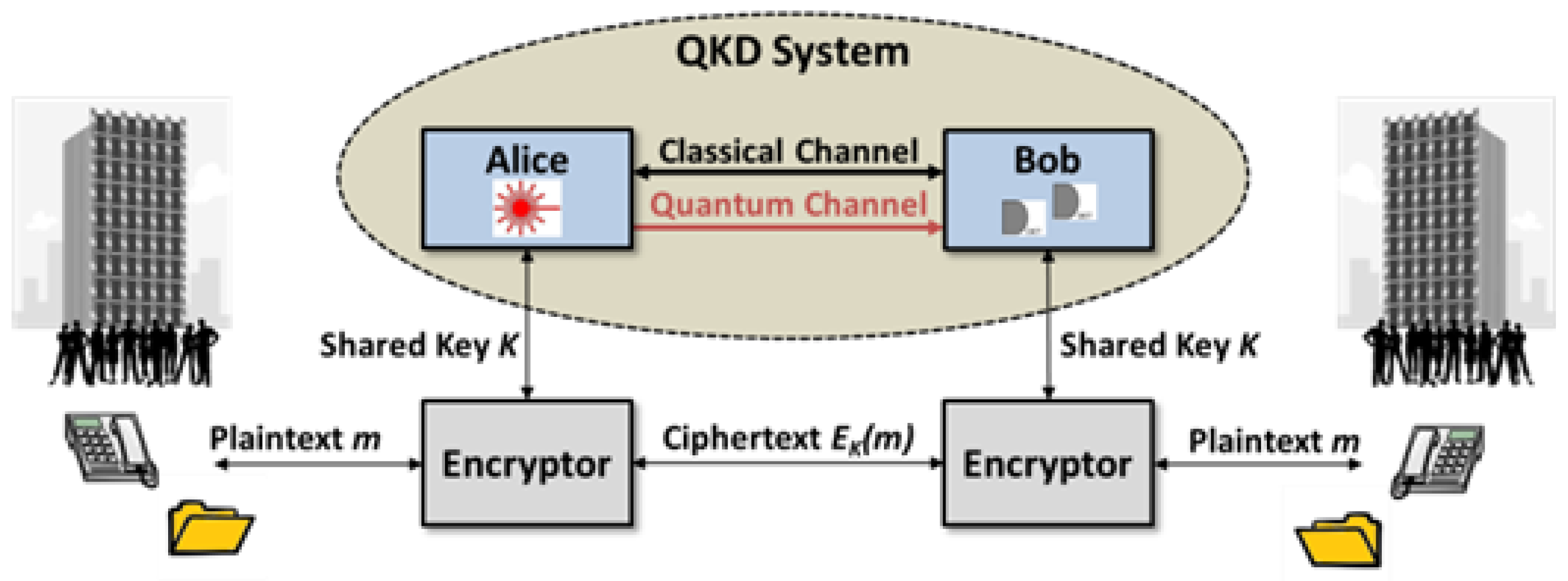
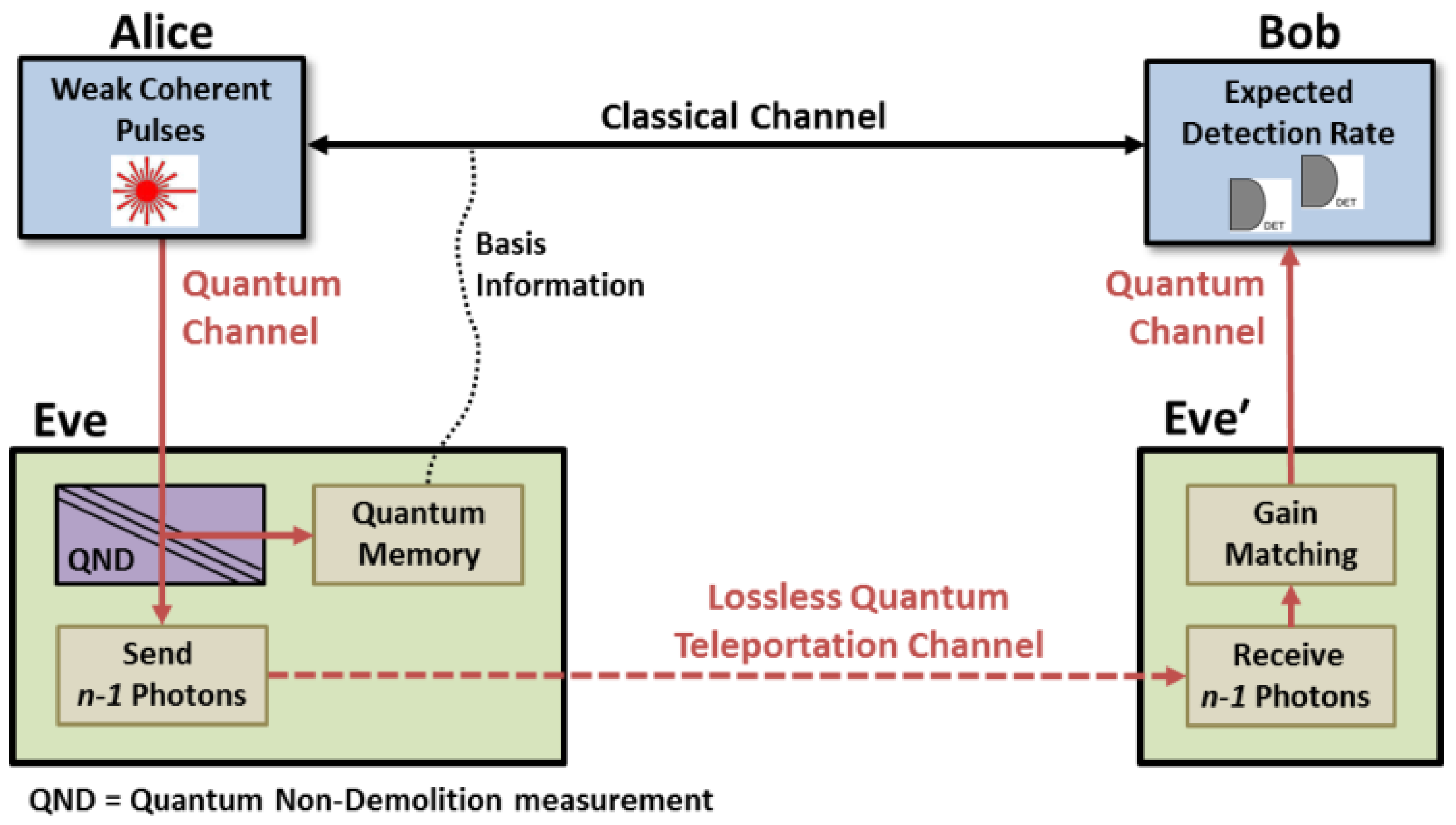
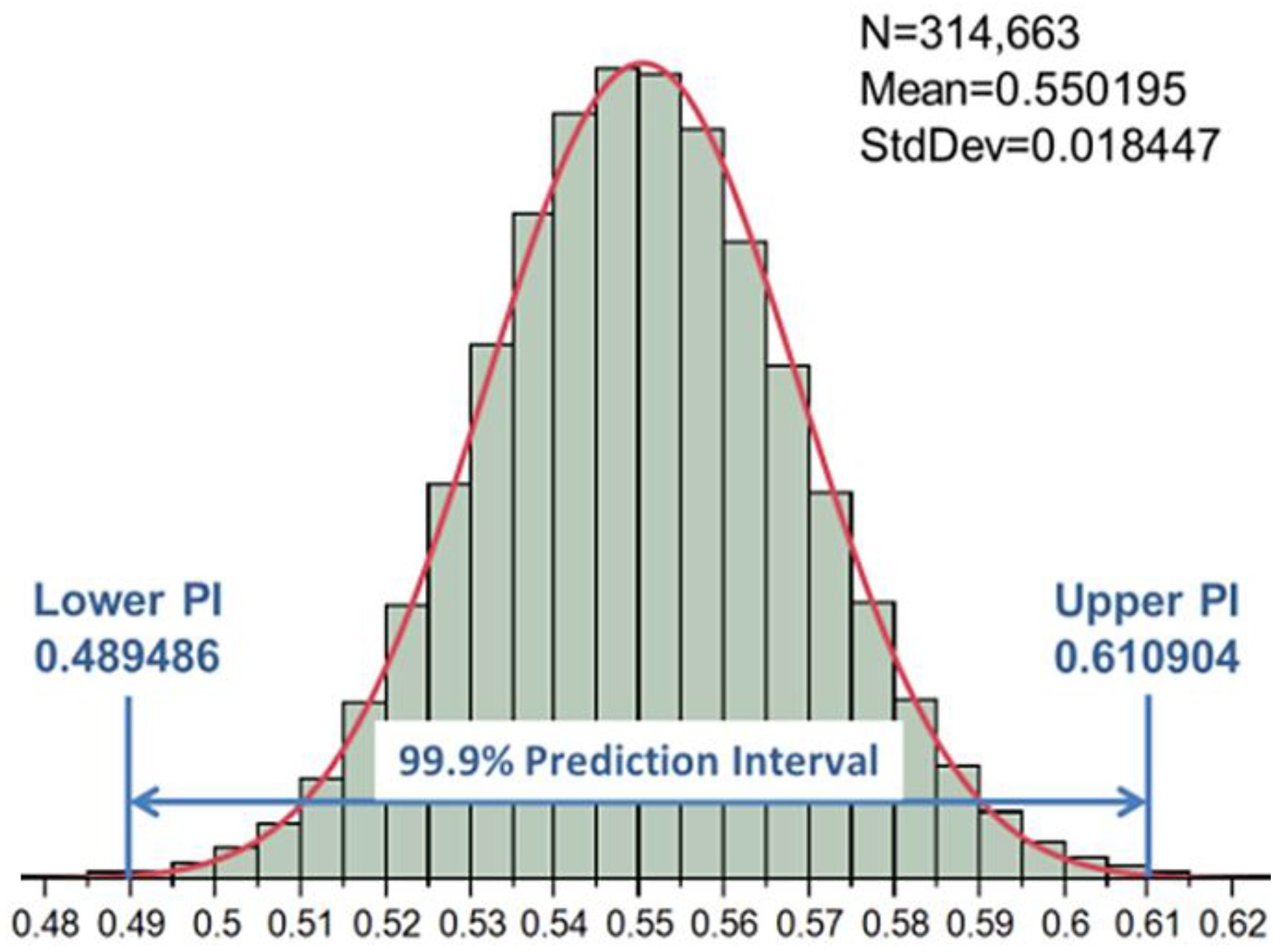
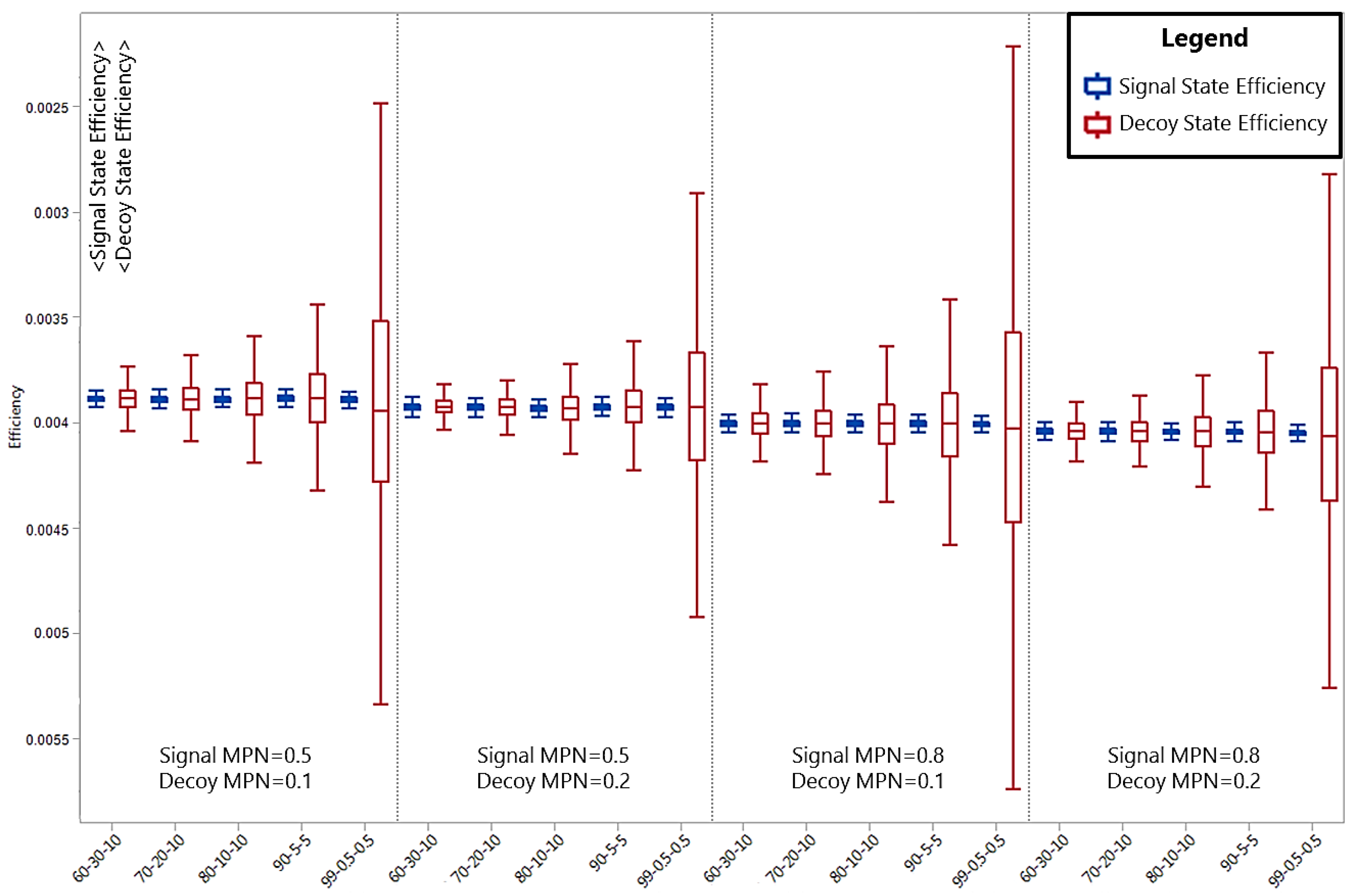

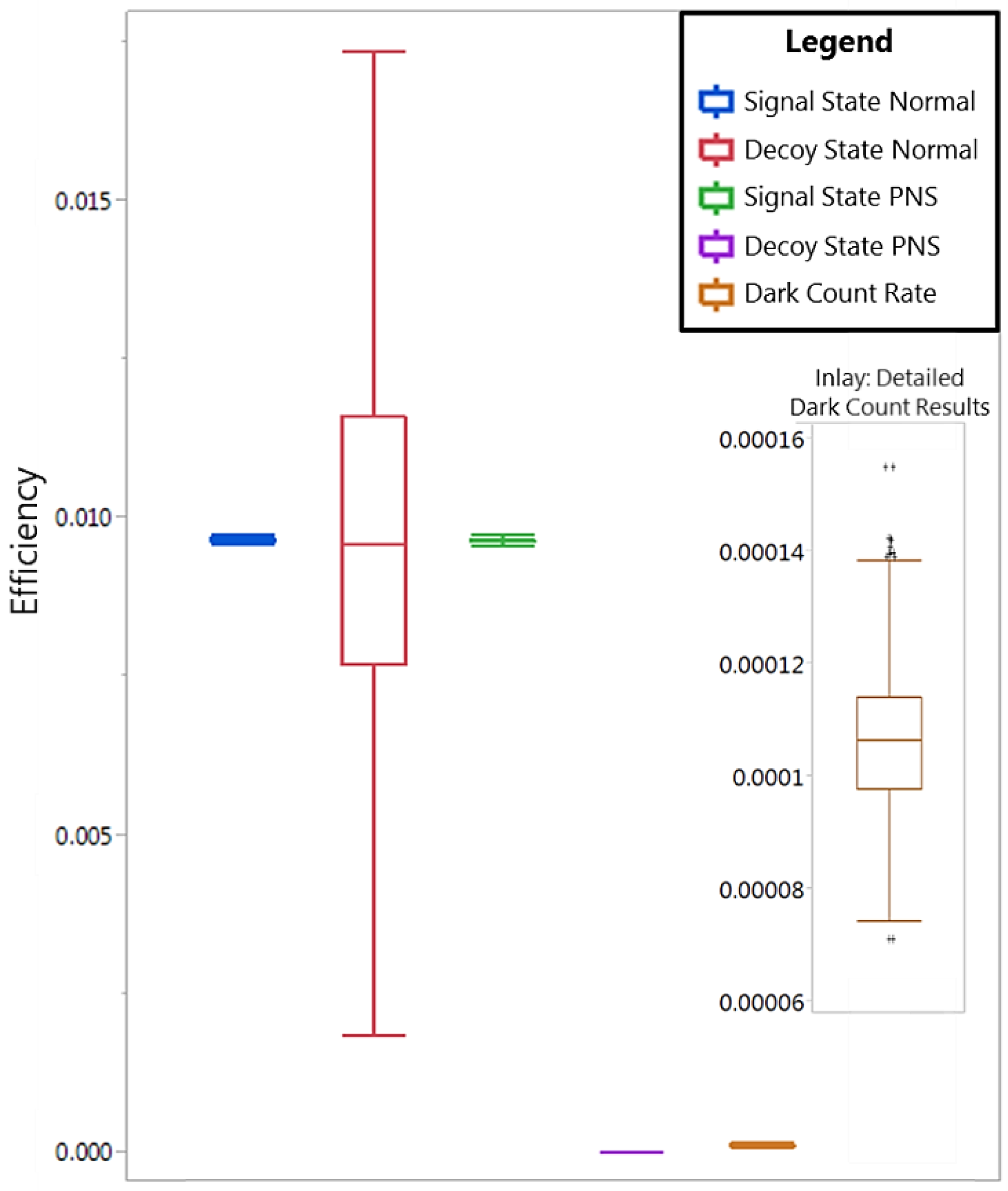

| Alice Prepares | Bob Measures | |||
|---|---|---|---|---|
| Bit | Basis | Prepared State | Basis | Result |
| 0 | 0 | |||
| 1 | 1 | |||
| 0 | random | |||
| 1 | random | |||
| 0 | random | |||
| 1 | random | |||
| 0 | 0 | |||
| 1 | 1 | |||
| State | Purpose | MPN | Occurrence Percentage |
|---|---|---|---|
| Signal | The signal state is used to generate secret key and facilitates improved performance by using a higher MPN (i.e., 0.5 is greater than the value 0.1 typically employed in non-decoy state protocol QKD systems). | 0.5 | 70% |
| Decoy | The decoy state is used to increase the likelihood of detecting unauthorized eavesdropping on the quantum channel through statistical differential analysis with the signal state. | 0.1 | 20% |
| Vacuum | The vacuum state is used to determine the noise on the quantum channel known as the “dark count” (i.e., detections when no photons are sent). | 0.0 | 10% |
| Parameter | Description |
|---|---|
| The protocol efficiency represents the overall efficiency of the QKD protocol (e.g., ). For example, in the classical BB84 protocol shown in Table 1, 50% of the detections will be sifted out because of Bob’s random choice of basis measurement. | |
| The estimated gain of pulses emitted by Alice with one photon (i.e., the single photons prepared by Alice and successfully measured by Bob). This value is typically calculated (or bounded) by several operational parameters such as, , , and . | |
| The estimated error rate associated with pulses emitted by Alice with a single photon. This value is typically calculated (or bounded) by several operational parameters such as, , , and . | |
| The gain of the signal state is calculated from system measurements, where | |
| The QBER of the signal state is calculated from system measurements, where | |
| The error reconciliation efficiency is dependent upon the signal state QBER with typical values of for QBERs . | |
| Uncertainty in the error rate or is calculated using Shannon’s binary entropy limit [15]. |
| Case | Signal MPN | Decoy MPN | Occurrence Percentage () | Propagation Distance (km) | Key Rate (bps) |
|---|---|---|---|---|---|
| 1 [46] | 0.80 | 0.12 | 90/10/0 | 15 | 165 |
| 2 [47] | 0.55 | 0.152 | 63.5/20.3/16.2 | 60 | <428 * |
| 3 [5] | 0.425 | 0.204 | 75/25/0 * | 25 | 5.5 k |
| 4 [48] | 0.6 | 0.2 | 50/40/10 | 75 | ~12 |
| 5 [48] | 0.6 | 0.2 | 50/40/10 | 102 | ~8 |
| 6 [49] | 0.487 | 0.064 | 83.1/12.3/4.6 | 85 | ~28 |
| 7 [49] | 0.297 | 0.099 | 83.1/12.3/4.6 | 100 | ~2 |
| 8 [50] | 0.27 | 0.39 | 87/9/4 | 144 | ~13 |
| 9 [51] | 0.55 | 0.098 | 93/6.2/1.6 ** | 20 | 10 k |
| 10 [52] | 0.48 | 0.16 | 93/6.2/1.6 ** | 25 | 5.7 k |
| 11 [53] | 0.55 | 0.10 | 80/16/4 | 20 | 1.02 M |
| 12 [54] | 0.57 | 0.13 | 70/20/10 | 140 | ~2 |
| 13 [55] | 0.65 | 0.08 | 75/12.5/12.5 | 20 | 1.5 k |
| 14 [55] | 0.60 | 0.20 | 75/12.5/12.5 | 20 | 1.6 k |
| 15 [55] | 0.6 | 0.2 | 50/25/25 | 200 | 11.8 |
| 16 [56] | 0.6 | 0.2 | 50/25/25 | 200 | 15 |
| 17 [57] | 0.5 | 0.1 | 98.83/0.78/0.39 | 50 | 1.002 M |
| 18 [58] | 0.6 | 0.2 | 75/12.5/12.5 | 8–60 *** | 1.2–4.5 k *** |
| 19 [30] | 0.65 | 0.1 | 87.5/6.25/6.25 | 30–80 *** | 0.8–16 k *** |
| 20 [29] | 0.4 | 0.04 | 98/1.5/0.5 | 45 | 300 k |
| Operational Distance | Signal MPN | Decoy MPN | Occurrence Percentage (Signal/Decoy/Vacuum) | PNS Attack |
|---|---|---|---|---|
| 20 km | 0.5 | 0.1 | 60/30/10 | No |
| 50 km | 0.8 | 0.2 | 70/20/10 | Yes |
| — | — | — | 80/10/10 | — |
| — | — | — | 90/5/5 | — |
| — | — | — | 99/0.5/0.5 | — |
| Protocol Configuration | Operational Results |
|---|---|
| — |
© 2017 by the authors. Licensee MDPI, Basel, Switzerland. This article is an open access article distributed under the terms and conditions of the Creative Commons Attribution (CC BY) license ( http://creativecommons.org/licenses/by/4.0/).
Share and Cite
Mailloux, L.O.; Grimaila, M.R.; Hodson, D.D.; Engle, R.; McLaughlin, C.; Baumgartner, G. Modeling, Simulation, and Performance Analysis of Decoy State Enabled Quantum Key Distribution Systems. Appl. Sci. 2017, 7, 212. https://doi.org/10.3390/app7020212
Mailloux LO, Grimaila MR, Hodson DD, Engle R, McLaughlin C, Baumgartner G. Modeling, Simulation, and Performance Analysis of Decoy State Enabled Quantum Key Distribution Systems. Applied Sciences. 2017; 7(2):212. https://doi.org/10.3390/app7020212
Chicago/Turabian StyleMailloux, Logan O., Michael R. Grimaila, Douglas D. Hodson, Ryan Engle, Colin McLaughlin, and Gerald Baumgartner. 2017. "Modeling, Simulation, and Performance Analysis of Decoy State Enabled Quantum Key Distribution Systems" Applied Sciences 7, no. 2: 212. https://doi.org/10.3390/app7020212






